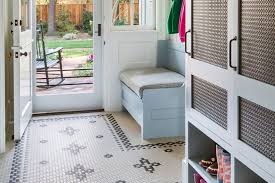The mudroom, often the first point of entry into a home, serves as a transitional space between the outdoors and the indoors. To make this high-traffic area both practical and stylish, selecting the right tile is crucial. In this article, we will explore the key factors to consider when choosing the best mudroom tile, balancing style, durability, and functionality for a space that seamlessly merges aesthetics with practicality.
Durability: The Foundation of Mudroom Tiles
Ceramic and Porcelain Tiles: Ceramic and porcelain tiles are renowned for their durability, making them ideal choices for mudrooms. These tiles resist scratches, stains, and moisture, ensuring that they can withstand the wear and tear associated with muddy shoes, wet umbrellas, and heavy foot traffic.
Natural Stone Options: Slate, granite, and travertine are excellent natural stone options known for their durability. While natural stones may require more maintenance than ceramic or porcelain, their unique textures and colors can add a touch of sophistication to the mudroom.
Easy to Clean and Maintain:
Sealed Tiles: Opt for tiles that are easy to clean and maintain. Sealed ceramic, porcelain, or natural stone tiles create a protective barrier against stains, spills, and dirt. Regular cleaning becomes a breeze, ensuring that the mudroom remains both functional and aesthetically pleasing.
Dark Colors and Patterns: Consider choosing darker-colored tiles or those with intricate patterns to conceal dirt and stains. This can be particularly advantageous in a mudroom where maintaining a consistently pristine appearance might be challenging.
Water and Moisture Resistance:
Non-Slip Surfaces: Mudrooms are prone to water, especially during rainy or snowy seasons. Select tiles with non-slip surfaces to prevent accidents. Textured porcelain or ceramic tiles, as well as some natural stones, provide traction, enhancing safety in wet conditions.
Water-Resistant Grout: In addition to the tiles themselves, pay attention to the grout. Opt for water-resistant or epoxy grout that inhibits moisture absorption, preventing mildew and mold growth in the grout lines.
Style and Aesthetics: Elevating Mudroom Design
Wood-Look Tiles: For a warm and inviting aesthetic, consider wood-look tiles. These porcelain or ceramic tiles mimic the appearance of hardwood while offering the durability and moisture resistance required in a mudroom. They provide a timeless, rustic charm to the space.
Hexagon or Herringbone Patterns: Experiment with different tile patterns to add visual interest to the mudroom. Hexagon or herringbone patterns, for instance, can inject a sense of style without compromising functionality. These patterns can be applied to the entire floor or used as an accent.
Patterned Cement Tiles: Patterned cement tiles bring a touch of vintage charm and personality to the mudroom. Their intricate designs and vibrant colors can transform the space, making it more than just a utilitarian entry point.
Size Matters: Choosing the Right Tile Size
Large Format Tiles: Large format tiles can create a seamless and visually appealing look in the mudroom. They minimize the number of grout lines, providing a sleek and modern appearance. Additionally, fewer grout lines mean less maintenance.
Mosaic Tiles: Mosaic tiles, on the other hand, offer flexibility and can be used to create intricate designs. They work well in smaller mudroom spaces or as an accent within a larger tiled area.
Cost-Effective Options:
Ceramic Tiles: If budget is a concern, ceramic tiles often present a cost-effective solution without compromising on durability. Ceramic tiles are available in a wide range of styles and colors, allowing you to achieve a stylish mudroom within budget constraints.
Porcelain Wood-Look Tiles: Porcelain wood-look tiles offer the warmth of hardwood without the associated cost. This option combines affordability with durability, making it a practical choice for those seeking a budget-friendly yet stylish mudroom flooring solution.
Climate Considerations:
Heated Flooring Systems: In colder climates, consider installing heated flooring systems beneath the tiles. Radiant floor heating not only adds a touch of luxury but also helps to keep the mudroom comfortably warm during chilly seasons.
Conclusion:
Choosing the best tile for your mudroom involves a careful balance of durability, style, and functionality. Whether opting for the timeless elegance of wood-look tiles, the durability of ceramic or porcelain, or the intricate patterns of cement tiles, the right choice can transform your mudroom into a welcoming space that effortlessly combines form and function. By considering factors such as water resistance, ease of maintenance, and personal style preferences, you can create a mudroom that not only withstands the challenges of everyday use but also enhances the overall aesthetic of your home.

